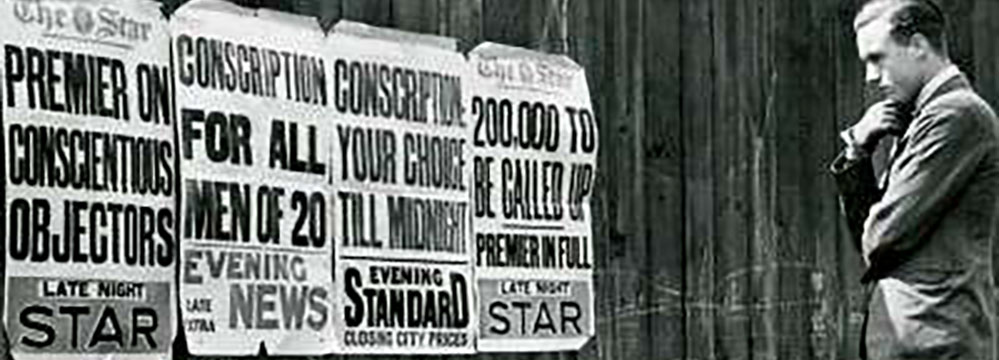
 |
 |
| Conscription | |
The British prime minister, Neville Chamberlain, had himself served on a tribunal (the panel interviewing COs to assess their request to be exempted from military service) in the First World War. He said that people asking for unconditional exemption should be respected. 'It was a useless and exasperating effort to attempt to force such people to act in a manner contrary to their principles.' If the principles were 'conscientiously held, we desire that they should be respected, and that there should be no persecution'. COs were once again required to face a tribunal, but this time the panel members were better chosen, and at least intended to be more fair. The chairman had to be a lawyer (usually a county court judge, not wearing judge's robes). Every tribunal panel had to have a trade union member on it, and, if the CO applicant was a woman, a woman member as well. There was no 'military representative'. As in the First World War, the tribunals had the power to allow full exemption from military service, without conditions; or exemption conditional on doing alternative civilian service; or exemption only from combatant duties in the army. Otherwise they could dismiss an application altogether. COs had the right of appeal against their tribunal's decision; the appeal ('appellate') tribunals were chaired by a High Court judge. There were a number of organisations which supported the COs, and all of them were represented on the Central Board for Conscientious Objectors (CBCO), set up in 1939 with government recognition as the organisation to consult on everything to do with conscientious objection. Many veteran COs from the 1914-1918 war manned about 100 CBCO groups which worked throughout the country to advise and inform COs, keep records (as the No-Conscription Fellowship had done in the previous war), monitor tribunals, lobby Parliament and generally protect the interests of COs. There was also the Pacifist Service Bureau (given a licence to operate by the London County Council), which worked to find suitable employment for COs who had been allowed conditional exemption. About 60,000 men and 1,000 women applied for exemption from armed service. Nearly 3,000 were given unconditional exemption. Around 18,000 were turned down altogether as not 'genuine'. The remainder were either allowed exemption conditional on doing alternative civilian work, or put on the military service register as non-combatants. About a third appealed against the decisions; subsequent appeal tribunals revised about half of these after re-examination. Of the COs who took up non-combatant duties, 6,766 ended up in the Non-Combatant Corps (NCC). This was set up in August 1940. It was divided into 14 companies mostly commanded by army veterans or reservists; 465 of these COs volunteered to specialise in bomb disposal. Others worked in army-run medical units or on other projects 'not involving the handling of military material of an aggressive nature'. Civilian work regarded by tribunals as most useful was agriculture or forestry, hospital work, and social service; towards the end of the war coal mining was added to the list. Civil defence was also favoured by tribunals, but a number of COs resisted it because of its closeness to military activity. For some COs alternative civilian service meant being ordered to stay in their present posts (for example, in education, scientific research or on the land), but many tribunals were keen to despatch applicants to work away from home, so that they made some sacrifice, as fighting men did. Each conscript woman was given the choice between the women's military services (no use of any 'lethal weapon' without her written consent), civilian defence, or work in industry, often in armaments factories. Women COs, it turned out, often had to appeal to gain exemption under conditions they could accept. Some women managed to make their own informal arrangements which were accepted as satisfactory, but these weren't listed in the records. By the end of the war, about 5,000 men and 500 women had been charged with offences to do with conscientious objection, and most of them were sent to prison. A further 1,000 or more were court-martialled and given prison sentences for refusing to obey military orders. What was life like for a CO in the Second World War? Their stories that follow show that their experiences were as varied as themselves, and as the experiences of their forerunners had been over twenty years earlier. | continue |
World War Two - Britain - INDEX |
| menwhosaidno.org | |